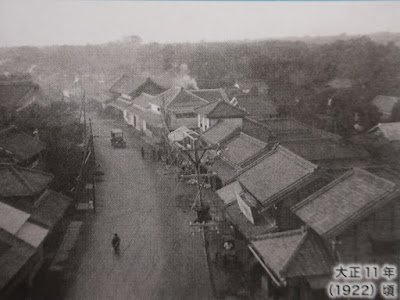Warabi in Saitama prefecture was the second post-town from Edo (old name of Tokyo). This museum faces the old highway. The exhibition area is as large as two classrooms. Attractive models are installed, but photography is prohibited unhappily.
埼玉県蕨市は、中山道で江戸から二つ目の宿。旧街道に面して建つ資料館である。展示スペースは教室二つぐらいで大きくないが、立派な模型がおいてある。撮影禁止なのが残念。
Warabi post-town、蕨宿(1922年、パンフレットから)
The
model (1:200) of the town is in the center of the main exhibition room.The town was around one kilometer long. There were 430 buildings including two honjin hotels for daimyo lords and one waki(substitute)-honjin hotel, and 2,223 people lived in 1843.
Reference: Kusatsu post-station Honjin 草津宿本陣
Tea houses were allowed to operate from sunrise to sunset only. One bowl of rice or confectionaries (specialties) were served, but travelers could not stay there.
There is a full-scale model of the entrance of an inn. A traveler soaks his foot in a tub and a maid rinses it.
There is also a tray served to a traveler on which there are simmered vegetables, rice and miso-soup.
The room for a daimyo lord in a honjin is exhibited, too. Three trays are served to a daimyo.
On the center tray: boiled cuttlefish, simmered vegetables, pickled vegetables, rice and miso-soup.
On the left tray: small fish
On the right tray: two vegetable dishes
These were served to a daimyo in Nagano who stayed here in 1844. These dishes were much richer than the dishes for an ordinary traveler, but it was still plain. We Japanese didn’t eat beef and pork back then.
Photos of the exhibits which I wrote are shown in the site below (must
check!):
展示室の中央には、宿場の1/200のジオラマが置かれている。
街道に沿って10町(約1km)、1843年で、人口2,223人、戸数430軒で、本陣が2軒、脇本陣が1軒であった。
参考ページ:Kusatsu Honjin 草津宿本陣(現存する最大級の旧本陣)
お茶屋の説明があり、営業時間は明け六つから暮れ六つ、要するに日の出から日の入りに制限されており、一膳飯や名物の菓子を出したという。旅人を泊めることは禁止されていた。この宿では、皇女和宮様も休憩されている。
また、桶川宿の文献を元にしたということだが、旅人に供されたお膳の模型がある。ご飯、汁物、野菜の煮物の三品だ。
続いて、商家の帳場、次は、本陣の上段の間が再現され、大名のお膳が置かれている。左側は、若魚子(わかなご、ぶりの幼魚)の皿を載せた膳。中央は、ご飯、里芋の味噌汁、野菜の煮物、イカのあんかけと漬物の五皿。右の膳は、レンコンと木の芽和え、白瓜の酢和えの二皿だ。旅人のお膳より豪華だが、質素なものである。1844年に泊まった牧野遠江守(小諸藩主、幕末で三万九千石)に供されたお膳である。草津宿本陣で見た皇女和宮様の休憩の時のお膳より、ずいぶん品数は少ないが、まあ、十分だ。
上記の写真は資料館のページにアップされている:
After S.Takahashi succeeded in a fabric business here, a fabric industry flourished in Warabi. Wooden looms and photos of Hata (loom) festival are exhibited.
蕨は、1826年、高橋新五郎が機屋で成功し、織物の街になる。木製の織機の展示、機(はた)祭りの写真が展示されている。
Hata festival、わらび機まつり(8月、パンフレットから)
Branch of the museum、資料館分館
The building was the fabric merchant house. We can take photos here.明治時代に織物の買継商をしていた旧家。こちらは撮影可能。
Layout of the building、屋敷のレイアウト
Shop front、店先
Wooden looms、機織り機
Inside of the main building、母屋
Nakasendou at present. I drove to Omiya while enjoying the atmosphere of this old highway.
旧中山道の今。ところどころの名残を楽しみながら、大宮まで走りました。
Location of Warabi on Nakasendou highway、中山道蕨宿
Visited in June, 2019
Website: https://www.city.warabi.saitama.jp/shogaigakushu/bunka/shiryokan/index.html
(Japanese), accessed in June, 2020
Previous post (Small museum in the same prefecture):
Next post (Largest historical museum in this prefecture):












Comments
Post a Comment